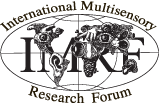“Bouba” and “Kiki” in Namibia? A remote culture make similar shape–sound matches, but different shape–taste matches to Westerners
Last modified: 2013-05-05
Abstract
Western participants consistently match certain shapes with particular speech sounds, tastes, and flavours. Here we demonstrate that the “Bouba-Kiki effect”, a well-known shape–sound symbolism effect commonly observed in Western participants, is also observable in the Himba of Northern Namibia, a remote population with little exposure to Western cultural and environmental influences, and who do not use a written language. However, in contrast to Westerners, the Himba did not map carbonation (in a sample of sparkling water) onto an angular (as opposed to a rounded) shape. Furthermore, they also tended to match less bitter (i.e., milk) chocolate samples to angular rather than rounded shapes; the opposite mapping to that shown by Westerners. Together, these results show that cultural–environmental as well as phylogenetic factors play a central role in shaping our repertoire of crossmodal correspondences.
Keywords
crossmodal correspondences; crosscultural; sound symbolism; taste; flavour


